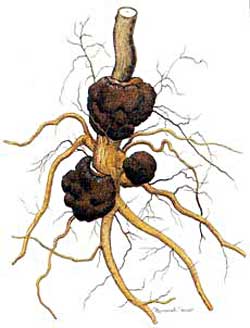
Crown gall of plants
Cause of crown gall
Crown gall infection is caused by various bacteria of the genus Agrobacterium (tumerogenic state).
Distribution and importance
The disease can occur wherever susceptible crops are grown. In New South Wales it occurs most commonly on stone fruit and some ornamentals, for example roses. It occurs less commonly on pome fruit, grapes and olives.
Crown gall causes greatest financial loss in the nursery, and large numbers of plants can be affected when they are dug for sale. In nurseries there have been losses of up to 80% of plants. Nurseries are required by law to reject all infected plants before sale.
Host range and cultivar reaction
The disease affects a wide range of plants including deciduous fruits, vine and berry fruits, vegetables and ornamentals. Within these groups of plants there is no known cultivar resistance.
Symptoms and effects

The illustration shows severe gall infection at the upper crown area on the roots of a peach seedling. Galls form on the crown of the plant (the point at the soil line where the main roots join the stem) and on the roots. They can also form on the main stem above soil level, or on the branches.
Galls first appear as small, pale, roughened lumps of tissue. They enlarge, darken, and become convoluted. The galls may vary in diameter, from 25–50 mm on nursery plants, up to 300 mm on trees in the field. The galls differ from those caused by root knot nematodes and some insects in that they contain no organised internal structure.
There may be no visible effect on the plant other than the galls. However, if infection is severe and many galls are present, plants, particularly young ones, may be stunted and unthrifty and may die if they are stressed by dry conditions. These symptoms are not diagnostic for crown gall, but the presence of the galls identifies the disease.
In the field, large trees appear to be unharmed by the disease, but they too can become unthrifty, and even die, if subjected to moisture stress.
Source of infection
The bacterium can live for many years in soil and can multiply in the root zone of susceptible plants. It infects the plant through a wound, usually at ground level or on the roots, and transfers a tumerogenic (cancerous) factor to some plant cells. These cells then start dividing uncontrollably, forming galls of undifferentiated tissue that restrict the normal functions of the plant.
Many nursery plants are infected through grafting and budding scars. The bacterium can also enter the plant through mechanical injury to crowns or roots. Such injuries may be caused by cultivation equipment, insects or animals.
Mode of spread
Crown gall infection is spread by movement of infested soil, by infected plant material, and via budding and grafting tools.
Conditions that favour spread
Conditions that favour spread include continuous in-ground nursery plantings of susceptible species, or any management practice that causes wounding to roots, crowns or stems without appropriate precautions to prevent infection.
Control
As there is no cure for infected plants, prevention of infection is essential. For nursery plantings, do not use soil in which crown gall infection of plants has occurred. Soil used in the nursery should be treated to eradicate crown gall bacteria as well as other pathogenic organisms.
Eliminate from the nursery any plants with galls or suspicious swellings at the graft union or near the soil level.
Budding and grafting tools should be treated with a disinfectant to stop the bacteria spreading during budding and grafting operations (consult your District Horticulturist regarding appropriate chemicals).
Nursery plants and transplants can be protected from crown gall by treating the seeds, seedlings or cuttings with a commercial biological control agent. This agent was developed in Australia and is now used by many nursery workers and orchardists. The agent is a live culture of a bacterium closely related to the crown gall bacterium. It protects wound sites from infection and should be used whenever highly susceptible plants are subjected to wounding, such as when striking cuttings, repotting, digging or planting. For effective action the agent must be applied within 2 hours of the damage. Closely follow the directions on the label.
In nurseries, multiple use of the agent may be necessary. Orchardists should repeat the control at planting. Bare-rooted plants may be trimmed and inoculated with the control before planting. Follow the directions given on the label closely.
The control agent is effective against strains of the crown gall bacterium found on most plants, including stone fruits and roses, but it is ineffective against the strain that infects grapevines. To ensure effective control, take the following precautions:
- Do not mix the control agent in chlorinated water.
- Do not expose the control agent to either very high or freezing temperatures.
- Do not expose the control agent to direct sunlight.
Further information
Professional growers may obtain further information on crown gall from the Plant Health Diagnostic Services at EMAI and Orange Agricultural Institute. Specimens to be identified or verified should be similarly addressed. Material posted should have the name and address of the sender marked clearly on the package. Dispatch of material should be timed to avoid its arrival just before the weekend.
Author: Peter Fahy (updated by Len Tesoriero)

